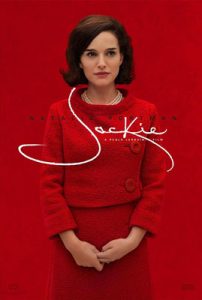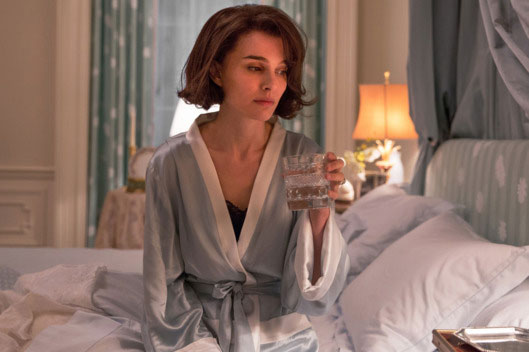The Dilemma of “Jackie”: Beautiful to Behold, Unbearable to Watch
Written by: Christopher Llewellyn Reed | December 24th, 2016

Jackie (Pablo Larraín, 2016) 1 out of 4 stars
We first meet her in close-up, shot in muted grays and blues, with a series of oddly centered compositions, smoking, walking, and then greeting a journalist – never named, but clearly Theodore White – who has come to Hyannisport, MA, a week or so after John F. Kennedy’s funeral to discuss her husband’s legacy. She’s a bundle of neuroses, alternately fidgety and calm, imperious in her will to control the conversation and shape the meaning of JFK for posterity. As they talk, the film cuts back and forth between this “present” and various moments from Jack and Jackie’s past, including the gruesome events on November 22, 1963. It’s this somber interview, however, that forms the main cinematic tapestry of the film, through which Chilean director Pablo Larraín (No) attempts to thread his narrative needle. Unfortunately, that needle soon becomes a leaden anchor, and those muted steely colors transform into an ocean of significance (in bold and underlined, throughout) in which the story drowns a soggy death. Not without aesthetic interest, the movie is still a complete mess, weighed down by an expositional script and extremely mannered performances.
On that aesthetic side, Larraín and his fine cinematographer Stéphane Fontaine (Rust and Bone, Captain Fantastic) shoot in Super 16, a now little-used format that, when blown up to the big screen (for 35mm or a DCP), displays a grainy quality that lends the image an automatic sense of archival material. Since Larraín occasionally intercuts actual historical footage, this makes those transitions relatively seamless, especially as he recreates Jackie’s 1962 White House tour. In addition, the period sets and costumes are all beautifully designed, plunging us into the time of the story in a direct, visceral way. This includes the actual assassination – already known by millions around the globe thanks to Abraham Zapruder’s 8mm home movie – which is, at first, presented tastefully, from a distance, as Jackie, in her pink suit, scrambles to hold on to her dying husband. Sadly, that restraint is later forgotten as we watch, in a subsequent scene, JFK’s head explode in foregrounded extreme close-up.

That excess is in line with most of the over-the-top acting. Natalie Portman (A Tale of Love and Darkness), an actress I normally admire, here creates a Jackie Kennedy who is all ticks and surface emotions, without a shred of internal life. There is, for sure, a good movie that could be made about how hard it is to understand public figures so consumed by their personae that they are now one-dimensional, but this is not that film, and Jackie was not such a person. The dialogue between Portman and Billy Crudup (Spotlight), as “the journalist” (as he is listed in the credits), certainly lacks dimension, however, treating the viewer to a series of declaratory statements about history and its interpretation that would not pass muster in a high-school paper. Of the remaining ensemble, perhaps the most egregiously miscast is Peter Sarsgaard (The Magnificent Seven) as Robert Kennedy, who not only is physically unfit for the role, but seems genuinely at a loss over how to handle the dramatically inept sequences into which he is dropped. As visually lovely to behold as most of this movie is, it is nevertheless unbearable to watch.

